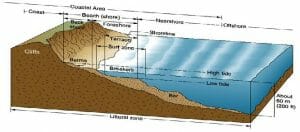Littoral Zone Definition
The littoral zone in an aquatic ecosystem (river, lake, sea) can be defined by the presence of sunlight at the sediment level, and the corresponding growth of partially-submerged to fully-submerged aquatic plants. It is also generally characterized by abundant dissolved oxygen, nutrients, water motion, and alternating intervals of submergence and exposure.

As detailed in the illustration above, the littoral zone typically extends from the beginning edge of the coast where the substrate and the organisms that inhabit it are often exposed to air and risk of desiccation, out to the beginning edge of the limnetic zone where the substrate is never exposed. However, there is no single definition of a littoral zone that is universally agreed upon. Depending on who you ask—and which field you’re studying—the definition of a littoral zone varies slightly to fit into that particular context.
In coastal environments, such as on the beach or shore, the littoral zone includes land up to the high water mark, which is often exposed to the air, and is often interchangeable with the term intertidal zone. In marine biology, the littoral zone includes areas of ocean extending to the ends of the continental shelf, and can be subdivided into three smaller zones based on areas of tidal action. From shallow to deep, these zones are the supralittoral zone, the eulittoral zone, and the sublittoral zone.
In freshwater environments such as lakes or rivers, the littoral zone includes wetlands, or the areas of land seasonally or permanently inundated by the body of water. Here, tides are unsubstantial and are not used to classify the range of area encompassed by the littoral zone. Instead, the different types of littoral zones found can be defined by the water depth and clarity, and by the shoreline profile. Types of zones found at higher to lower elevations, respectively, include the wooded wetlands, the wet meadows, marshes, and the substrate supporting aquatic plant life.
Littoral Zone Organism
The littoral zone and its sub-zones are distinctive environments with equally distinctive organisms. The types of organisms found at each level of the littoral zone are adapted to the particular challenges presented by each location and its proximity to water and land. In areas with substantial wave action, such as marine coasts and its intertidal zones, organisms are adapted to daily changes in salinity, moisture, water turbulence, temperature, and predation by both land and sea creatures. In addition, depending on whether organisms are mobile or not, survival mechanisms for feeding and respiring become a more integral part of their adaptations for survival.
Animals
Organisms that are mobile—such as crabs, snails, and limpets—can seek shelter from the predators and the drying heat of the sun by hiding in the shade provided by rocks, seaweed, mud or sand, and small fissures found in their environment. Other motile animals that can be found burrowed under the sediments include mud shrimp and worms. Non-motile organisms like the barnacle or mussel are anchored by an organic cement to solid substrates to prevent the tides from carrying them out to sea. Being stationary leaves these organisms open to predation by sea stars, especially if anchored closer to the sediment; however, when anchored in areas of higher tides, these creatures can sit out of reach of their predators and use their shells to capture water for use during low tides.
Plants
Many types of plants have become adapted to life being only partially submerged, and others have adapted to life being totally submerged. Eelgrass is a type of flowering submerged aquatic vegetation (SAV) with rhizomes that help to store excess nutrients for later development. Strap weed is another type of SAV that increases the amount of sunlight it receives by utilizing an air-filled bladder that positions most of its body closer to the surface where more light is available. Kelp has developed a very sturdy root system that keeps the organism anchored to the substrate, despite violent wave action that threatens to pull non-rooted organisms out to sea.
Fungi
Species like lichen which are found in rocky intertidal habitats have a fungal symbiont that can store water and protect them from desiccation, as well as an algal or cyanobacteria symbiont that photosynthetically produces food for the organism. Having the ability to lose large amounts of water, dry out, and then bounce right back to life once water is available makes the lichen impressively drought resistant.
Quiz
1. What is a limiting factor for plants in the littoral zone?
A. Dissolved oxygen
B. Water
C. Air
D. Sunlight
2. Which statement about the littoral zone is false?
A. It is abundant in dissolved nutrients and oxygen.
B. Survival in the littoral zone depends heavily on one’s ability to outrun predators.
C. The definition varies between marine and freshwater ecosystems.
D. It can be further subdivided into smaller zones.
3. Which is not found in the littoral zone?
A. Wetlands
B. Intertidal zone
C. Supralittoral zone
D. Limnetic zone
References
- Adaptations. (n.d.). Retrieved June 08, 2017, from http://intertidalproject.weebly.com/adaptations.html
- Fun Facts About Fungi. (n.d.). Retrieved June 08, 2017, from http://herbarium.usu.edu/fungi/FunFacts/lichens.htm
- Intertidal Zone. (2013, November 14). Retrieved June 08, 2017, from https://www.crd.bc.ca/education/our-environment/ecosystems/coastal-marine/intertidal-zone
- Littoral zone. (2017, June 04). Retrieved June 08, 2017, from https://en.wikipedia.org/wiki/Littoral_zone
